This past December (2019), I arrived in Strasbourg, France, almost exactly 20 years after my first and only other visit. There have been changes — new construction and the like — but the historic center is reassuringly much the same. Indeed, I can offer a few old photos below (scanners are such wonderful things).
Strasbourg, with a population these days of around 280,000, sits in Alsace in northeastern France, inches from the German border (and was part of Germany for a time, 1871-1918). It is now the official seat of the European Parliament.
Strasbourg’s central attraction any time of year is Old Town, located on the UNESCO-protected Grande Ile, an island in the Ill River; in December, Christmas markets are an additional draw.
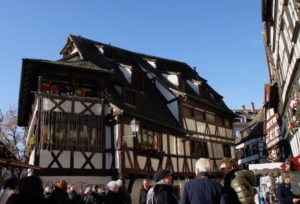
Half-timbered houses overlook the Christmas market in La Petite France, an area of Grande Ile where tanners once worked. Seen at bottom, market goers explore shopping choices.
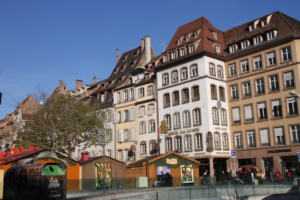
Another Strasbourg Christmas market with stalls seen against the backdrop of a residential area of Grande Ile in Strasbourg.
On my recent trip, I accompanied a group of travel agents on a Rail Europe-sponsored learning tour, which was built around French holiday markets — and there are a lot of those.
In Strasbourg, several were clustered on Grande Ile, positioned along the riverside or in small squares surrounded by half-timbered houses, which were themselves festooned with all manner of Christmas decorations. The markets weren’t just charming; the shopping was pretty good, too.
The largest of these markets huddled around the city’s medieval cathedral. A red sandstone building that stands 466 feet tall, the cathedral was the world’s tallest manmade structure from 1439 to 1880 (when it was outstripped by Cologne’s cathedral).
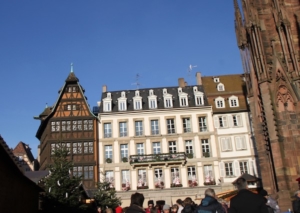
Strasbourg’s cathedral (a sliver appears at right) and Maison Kammerzell, upper left, overlook the holiday shopping in Cathedral Square. Strasbourg’s tourist office is in the building to the right of Maison Kammerzell.
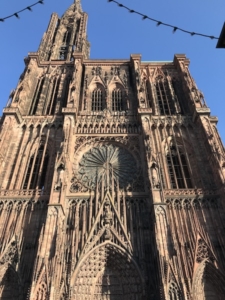
The world-renowned Strasbourg Cathedral, built of red sandstone and centuries in the making.
Constructed between 1176 and 1439, Strasbourg’s cathedral was built on bundles of oak piles that have since been reinforced with concrete. Its style is described as Romanesque and Gothic. Belying its size, architectural details made it seem as delicate as lace.
I was inside the cathedral in 1999 but, during my more recent visit, there wasn’t time to deal with the lines. Our group was in town only 18 hours; travel agent learning trips are fly-by affairs.
But, in those 18 hours, my fellow travelers and I jammed in a lot, as follows:
Ours was an evening arrival by train. A tram took us to one of the bridges that accesses Grande Ile, site of our hotel.
After walking the bridge, we were met with an open-bag security check, meaning we had to open our checked bags as well as everything else. The 2018 Strasbourg Christmas markets were the scene of a terrorist attack. Later, we saw armed men in camouflage strolling the market areas. We also encountered security checks (opening carry-along bags) when boarding our boat for a river cruise and when entering the tourist office on Cathedral Square.
Meanwhile, after our evening hotel check-in, we walked to a few well-lighted markets plus squares and streets colorful with their holiday lights. We could see residents are really into decorating for the season, especially the fronts of businesses, with holiday-related figures and themes.
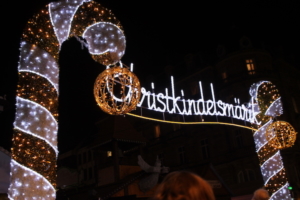
The entry to one of Strasbourg’s Christmas markets. The German-language sign, Christkindelsmarkt, reflects Strasbourg’s proximity to the German border. Also, at one time, Strasbourg was part of Germany.
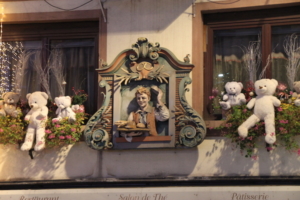
Holiday decorations featuring teddy bears, a favorite motif in Strasbourg.
From this walk, I remember best the market that sits in Old Town’s La Petite France district, an area where tanners once worked. A couple of 1999 photos taken here decorate my walls at home. The half-timbered houses, often reflected in the river, remain fabulous sights today.
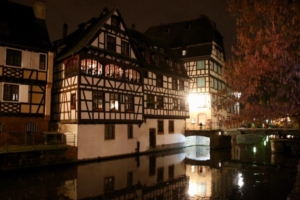
Nighttime views of half-timbered houses in La Petite France, a small section of Strasbourg’s Old Town.
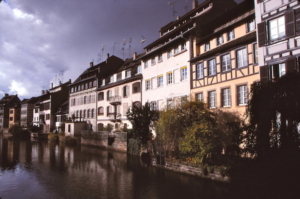
This 1999 photo of La Petite France brightens my living room wall.
Dinner was at Maison Kammerzell on Cathedral Square to sample fish sauerkraut, a dish that has become this eatery’s specialty and, apparently, well known around the world (though not to me).
I was much more interested in the building, which dates from 1427 and is a very evocative half-timbered house. The ground floor is the cellar for a wine bar with vaulted ceilings and a generally medieval look.
We were seated on the second floor overlooking Strasbourg Cathedral, but that did not translate into clear views because we were peering through the sort of windows that look like collections of glass from the bottom of wine bottles, lashed together with metal, reinforcing the medieval aura.
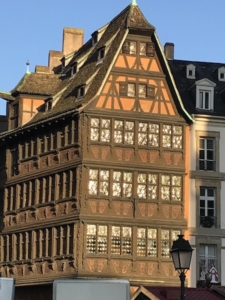
Maison Kammerzell, a 600-year-old house on Cathedral Square and site of the eponymous restaurant.
The eatery takes its name from a 19th century owner, Philippe-François Kammerzell, who was a grocer. The city owns this place now.
After dinner, we walked to our hotel.
Our daylight hours began with a 70-minute cruise around Grand Ile, with boarding at La Petite France, a happy chance to see the area’s iconic half-timbered buildings again but in full sun.
Given it was winter, the boat, operated by Batorama, was fully enclosed and warm, but that was less good for photos. I took them anyway, but there is always the interference from the glass with its distortions and tinting, a slight greenness.
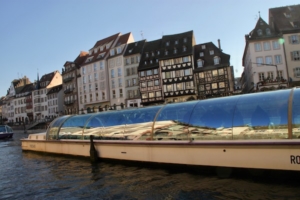
Our sightseeing boat on the Ill River.
The journey began with great views of the medieval Old Town, eye candy to me, but led to sightings of the 19th century Imperial district, or Neustadt, built when this was the kaiser’s turf. Also, we saw the European Parliament buildings; these are modern glass and steel creations, actually with lots of glass.
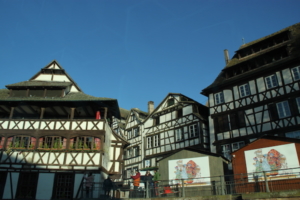
La Petite France with Christmas market stalls, lower right, viewed from the Batorama vessel.
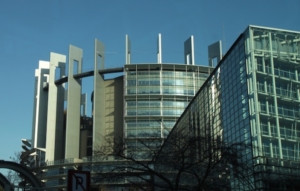
Part of the European Parliament complex viewed from Batorama’s enclosed sightseeing boat.
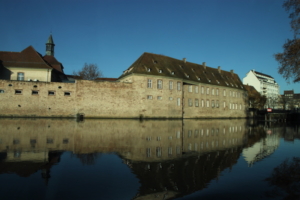
Also seen from our cruise, a medieval waterside complex, the St. John Commandery, which has had many lives, as a monastery, hospital, prison and now the French national school of administration.
We passed through locks twice, once outbound and once on the return; it appeared the locks protect a short section of landscape in Old Town.
There was narration via earphones, but I heard little of it because I couldn’t stay tethered to a machine and hop from one side of the boat to the other for photos. I favored the photos.
After disembarking, with a guide, we got serious about market visits, including the very busy one near the river in La Petite France (specializing in locally made things — especially foods, it seemed), then ending our rounds back at Cathedral Square for personal sightseeing, a visit to the tourist office (for the cutest postcards), shopping and, irresistibly, more gawking at the cathedral itself.
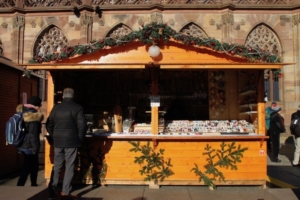
Above and below, stalls in Strasbourg’s holiday markets.

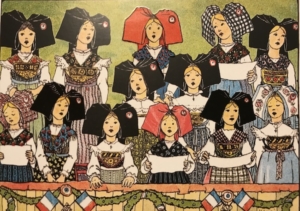
A postcard too cute to ignore, illustrating the look of traditional dress for Alsatian women.
From here, it was hustle time — to our train for a 1 p.m. departure!
For more information about France, we offer at BestTripChoices.com the following, under the headline, S’il vous plait, at France.
This blog and its photos are by Nadine Godwin, BestTripChoices.com editorial director and contributor to the trade newspaper, Travel Weekly. She also is the author of “Travia: The Ultimate Book of Travel Trivia.”
Postscript: Below is a selection of my photos, taken in 1999. I’m showing them off because I’m thrilled so many of these scanned slides look as good as they do!
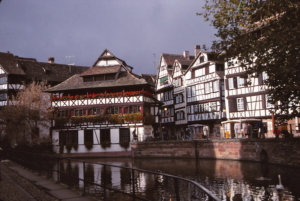
Above and below, houses in La Petite France, aka, the Tanners Quarter.
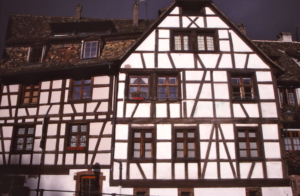
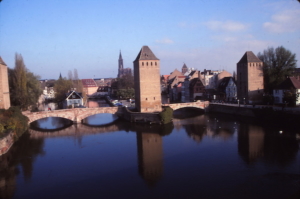
Fourteenth century towers, the remains of old ramparts, overlook Strasbourg’s so-called covered bridges and the Ill River. The bridges lost their roofs in the 18th century.

One merchant’s artfully organized product display.
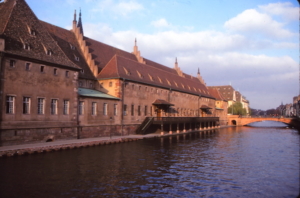
Strasbourg’s Old Custom House dating from the 14th century. It houses a restaurant nowadays.
